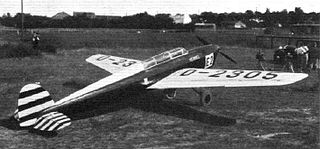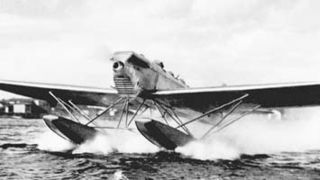
The Heinkel He 178 was an experimental aircraft designed and produced by the German aircraft manufacturer Heinkel. It was the world's first aircraft to fly using the thrust from a turbojet engine.

The Messerschmitt Me 264 was a long-range strategic bomber developed during World War II for the German Luftwaffe as its main strategic bomber. The design was later selected as Messerschmitt's competitor in the Reichsluftfahrtministerium's Amerikabomber programme, for a strategic bomber capable of attacking New York City from bases in France or the Azores.

The Henschel Hs 132 was a World War II dive bomber and interceptor aircraft of the German Luftwaffe that never saw service. The unorthodox design featured a top-mounted BMW 003 jet engine and the pilot in a prone position. The Soviet Army occupied the factory just as the Hs 132 V1 was nearing flight testing, the V2 and V3 being 80% and 75% completed.

The Heinkel He 116 was an extremely long-range mail plane designed to deliver airmail between Germany and Japan. Several examples were built for this role, as well as a small batch to be used in the long-range reconnaissance role.

The Heinkel He 118 was a prototype German monoplane dive bomber design that lost out to the Junkers Ju 87 Stuka in the 1930s, and was never ordered by the Luftwaffe.

The Heinkel He 45 was a light bomber produced in Germany in the early 1930s, one of the first aircraft adopted by the newly formed Luftwaffe. Its appearance was that of a conventional biplane and included seating for pilot and gunner in tandem, open cockpits. Developed in parallel with the He 46, it appeared in 1931 as a general-purpose biplane and was employed mainly as a trainer, but was also used by the Luftwaffe for reconnaissance and light bombing duties. Production of this plane totalled 512 aircraft, including those built under licence by Gotha, Focke-Wulf, and BFW.

The Heinkel HD 42 50, later designated the Heinkel He 42 was a German two-seat biplane seaplane originally designed for the Deutsche Verkehrsfliegerschule, and later built for the German Luftwaffe. The aircraft was used until the end of World War II as a trainer for maritime pilots.

The Junkers Ju 46 was a German shipborne catapult-launched seaplane derivative of the W 34, constructed for pre-war Luft Hansa's mail service over the Atlantic Ocean. The first production models were delivered in 1932 and replaced the Heinkel He 58, which, along with the He 12, had pioneered these ship-to-shore mail delivery flights.

The Heinkel HE 8 was a reconnaissance floatplane built in Germany in the late 1920s. It was developed at the request of the Danish Navy, which had noted the success of the HE 5 in Swedish service, and wished to purchase a similar aircraft as well as licensed production as the Orlogsvaerftet HM.II. Apart from its new Armstrong Siddeley engine, the HE 8 also differed from the HE 5 and previous members of the HE 1 family in having a conventional empennage. 22 aircraft were operated until the German invasion in 1940, after which one example was impressed into Luftwaffe service and the remainder placed in storage.

The Heinkel HE 12 was a pontoon-equipped mail plane built in Germany in 1929, designed to be launched by catapult from a liner at sea.

The Heinkel HD 24 was a training seaplane developed in Germany in the late 1920s. It was a conventional single-bay biplane with equal-span, staggered wings. The fuselage was braced to both the upper and lower wings with a number of struts on its sides, in addition to the normal cabane struts. The pilot and instructor sat in tandem, open cockpits, and the undercarriage consisted of twin pontoons, although this could be readily exchanged for wheels or skis.

The Heinkel HD 39 was a special-purpose cargo aircraft developed in Germany in the 1920s to distribute the Berlin newspaper B.Z.. It was a conventional single-bay biplane with staggered wings of equal span, and a fuselage that nearly filled the interplane gap. The pilot sat in an open cockpit, and the undercarriage was of fixed, tailskid type with divided main units. The sole example of the type was built after Ernst Heinkel found out, by chance, that B.Z. required such an aircraft and had ordered two machines from Albatros. Heinkel convinced publisher Ullstein-Verlag to purchase a third aircraft from his firm.

The Heinkel He 64 was a sports plane built in Germany in 1933 to participate in the touring plane championships that year, designed by Siegfried and Walter Günter.

The Boeing XPB was an American twin-engined biplane long-range patrol flying boat of the 1920s. A single example was built for the United States Navy.

The Messerschmitt P.1110 was a design for a single-seat, high-altitude interceptor, prepared for the German Luftwaffe by the Messerschmitt aircraft manufacturing company, under the Emergency Fighter Program during the last months of World War II.

The Heinkel HD 14 was a single-engine biplane torpedo aircraft developed by the German aviation company Ernst Heinkel Flugzeugwerke in the 1920s, and produced in a single prototype, under license, from Swedish by Svenska Aero in Stockholm.
The Heinkel HD 16 was a single-engine biplane torpedo aircraft developed by the German aviation company Ernst Heinkel Flugzeugwerke in the nineteen-twenties and produced under license by Svenska Aero in Stockholm, Sweden.

The Heinkel HE 9 was a reconnaissance seaplane developed by the German aviation company Ernst Heinkel Flugzeugwerke AG in the late 1920s.
The Heinkel HE 7 was a reconnaissance torpedo-bomber developed by the German aeronautical company Heinkel Flugzeugwerke in the late 1920s.
The Heinkel HD 44 was a special-purpose light transport aircraft developed in Germany in the 1920s.


















